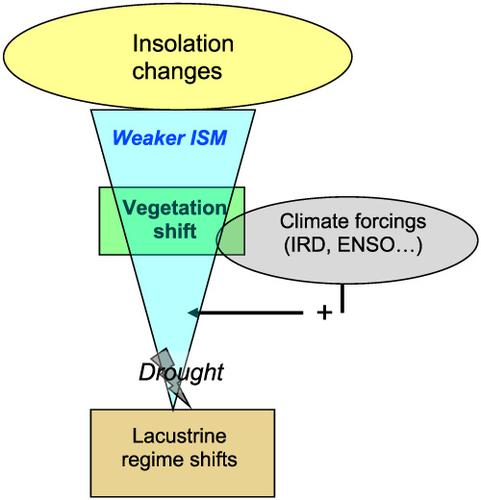当前位置:
X-MOL 学术
›
Earth Surf.Process. Land.
›
论文详情
Our official English website, www.x-mol.net, welcomes your feedback! (Note: you will need to create a separate account there.)
Holocene climate forcings and lacustrine regime shifts in the Indian summer monsoon realm
Earth Surface Processes and Landforms ( IF 3.3 ) Pub Date : 2020-09-18 , DOI: 10.1002/esp.5004 Sushma Prasad 1, 2 , Norbert Marwan 2, 3 , Deniz Eroglu 4 , Bedartha Goswami 3 , Praveen K. Mishra 5 , Birgit Gaye 6 , A. Anoop 7 , N. Basavaiah 8 , Martina Stebich 9 , Arshid Jehangir 10
Earth Surface Processes and Landforms ( IF 3.3 ) Pub Date : 2020-09-18 , DOI: 10.1002/esp.5004 Sushma Prasad 1, 2 , Norbert Marwan 2, 3 , Deniz Eroglu 4 , Bedartha Goswami 3 , Praveen K. Mishra 5 , Birgit Gaye 6 , A. Anoop 7 , N. Basavaiah 8 , Martina Stebich 9 , Arshid Jehangir 10
Affiliation

|
Extreme climate events have been identified both in meteorological and long‐term proxy records from the Indian summer monsoon (ISM) realm. However, the potential of palaeoclimate data for understanding mechanisms triggering climate extremes over long time scales has not been fully exploited. A distinction between proxies indicating climate change, environment, and ecosystem shift is crucial for enabling a comparison with forcing mechanisms (e.g. El‐Niño Southern Oscillation). In this study we decouple these factors using data analysis techniques [multiplex recurrence network (MRN) and principal component analyses (PCA)] on multiproxy data from two lakes located in different climate regions – Lonar Lake (ISM dominated) and the high‐altitude Tso Moriri Lake (ISM and westerlies influenced). Our results indicate that (i) MRN analysis, an indicator of changing environmental conditions, is associated with droughts in regions with a single climate driver but provides ambiguous results in regions with multiple climate/environmental drivers; (ii) the lacustrine ecosystem was ‘less sensitive’ to forcings during the early Holocene wetter periods; (iii) archives in climate zones with a single climate driver were most sensitive to regime shifts; (iv) data analyses are successful in identifying the timing of onset of climate change, and distinguishing between extrinsic and intrinsic (lacustrine) regime shifts by comparison with forcing mechanisms. Our results enable development of conceptual models to explain links between forcings and regional climate change that can be tested in climate models to provide an improved understanding of the ISM dynamics and their impact on ecosystems. © 2020 John Wiley & Sons, Ltd.
中文翻译:

印度夏季风季风的全新世气候强迫和湖相变化
在印度夏季风(ISM)领域的气象和长期代理记录中都已识别出极端气候事件。但是,尚未充分利用古气候数据潜在的机制来了解长期触发气候极端事件的机制。代表气候变化,环境和生态系统变化的代理之间的区别对于实现与强迫机制(例如,厄尔尼诺南方涛动)的比较至关重要。在这项研究中,我们使用数据分析技术[多重递归网络(MRN)和主成分分析(PCA)]对来自两个不同气候区域的两个湖泊-Lonar湖(以ISM为主)和高海拔Tso湖泊的多代理数据进行解耦莫里里湖(ISM和西风影响)。我们的结果表明(i)MRN分析,环境条件变化的指标,与单一气候驱动因素的地区的干旱有关,但在多重气候/环境驱动因素的地区,结果不明确;(ii)在全新世早期湿润时期,湖泊生态系统对强迫“不那么敏感”;(iii)只有一个气候驱动因素的气候区档案对政权转移最为敏感;(iv)数据分析成功地确定了气候变化发生的时间,并通过与强迫机制进行比较,区分了外部和内在(湖相)政权转移。我们的结果可以开发概念模型来解释强迫与区域气候变化之间的联系,可以在气候模型中对其进行检验,以更好地了解ISM动态及其对生态系统的影响。
更新日期:2020-09-18
中文翻译:

印度夏季风季风的全新世气候强迫和湖相变化
在印度夏季风(ISM)领域的气象和长期代理记录中都已识别出极端气候事件。但是,尚未充分利用古气候数据潜在的机制来了解长期触发气候极端事件的机制。代表气候变化,环境和生态系统变化的代理之间的区别对于实现与强迫机制(例如,厄尔尼诺南方涛动)的比较至关重要。在这项研究中,我们使用数据分析技术[多重递归网络(MRN)和主成分分析(PCA)]对来自两个不同气候区域的两个湖泊-Lonar湖(以ISM为主)和高海拔Tso湖泊的多代理数据进行解耦莫里里湖(ISM和西风影响)。我们的结果表明(i)MRN分析,环境条件变化的指标,与单一气候驱动因素的地区的干旱有关,但在多重气候/环境驱动因素的地区,结果不明确;(ii)在全新世早期湿润时期,湖泊生态系统对强迫“不那么敏感”;(iii)只有一个气候驱动因素的气候区档案对政权转移最为敏感;(iv)数据分析成功地确定了气候变化发生的时间,并通过与强迫机制进行比较,区分了外部和内在(湖相)政权转移。我们的结果可以开发概念模型来解释强迫与区域气候变化之间的联系,可以在气候模型中对其进行检验,以更好地了解ISM动态及其对生态系统的影响。


























 京公网安备 11010802027423号
京公网安备 11010802027423号